
In many ways, smart trainers themselves have largely flat-lined in terms of new features. Sure, we’ll continue to see new models with relatively minor tweaks, but much of the focus for the indoor smart trainer world has been on accessories lately. And that’ll likely continue for the foreseeable future. One such category is motion accessories, commonly called rocker plates. Though, not all rocker plates are created equally, and they’ve got vast differences in what type of motion, how much motion, and the direction of motion.
And thus this brings us to the Gymrail Momentum X1 which is by far one of the craziest rocker contraptions I’ve seen make it to production. Unlike most rocker plates, this is a split-component design (kinda like the Inside Ride E-Flex system). This means that you’ve got one portion holding up your front fork doing its thing, while another holds up your entire trainer and the remainder of the bike frame.
Between these two components, you and your bike will tilt side to side while concurrently moving forward and backwards. Your handlebars also rotate slightly (which is what enables rotation elsewhere in the bike). However, the kicker here is that, unlike most rocker systems, the rear/trainer portion of your bike also moves laterally side to side, thus accenting movement (both steady-state and sprint). And that combined with the rotational portion allows the whole thing to kinda ‘snake’ along.
Note that Gymrail sent over a Momentum X1 earlier this year to try out for a few months. Once I’m done with this review, it’ll get shipped back to them like normal. Just the way I roll. If you find this review useful, you can use the links at the bottom, or consider becoming a DCR Supporter which makes the site ad-free, while also getting access to a semi-weekly video series behind the scenes of the DCR Cave. And of course, it makes you awesome.
With that, let’s get into it.
Unboxing & Setup:
The Momentum X1 comes in two boxes. The flat box is just the flat plate as you’ll see in a second, whereas the bigger box is a collection of other parts including the front portion as well as rollers/pieces for the rear portion. Here are all the parts laid out:
Essentially, there are a few major part groupings here:
A) The rear board + skateboard that goes under it (including screws)
B) The front assembly, including the fork stand
C) The straps that hold your trainer on the rear board/assembly
D) The various axle adapters for your specific bike
You can see the straps and adapters here:
First up is taking a screwdriver out. Preferably a good one, and preferably one that aspires to be a drill – since that’s effectively what it’ll be doing in a moment.
Next, you’re going to place the roller system on the plate. You’ll notice I’ve pointed out with my fingers the screw holes on the skateboard. This is notable because there are no holes on the board itself. You’ll be creating those holes via the screwdriver by rotating the included sharp screws into the wood.
The only downside to that is that they very slightly start to poke through the board. I mean, it’s barely visible here, but that would be my only minor complaint here. Once you stick a trainer on them, you’d likely never notice them.
Now, with the wheels on the rear plate, it’s time to turn our attention to the front plate:
Despite looking like a folded-up spider that’s about to attack you, it’s actually pretty straightforward. You just swing the very sturdy feet out from under it, and then lock them in place with the screws. If there’s anything you should come away with as a takeaway here is that this front thing is built like a tank. It’s the CompuTrainer of rocker plates systems.
You’ll then rotate the feet out to ideally the same height, else…well, nobody wants a tipsy platform. I mean, I guess unless you were literally building a rocker platform. But this part of the rocker system shouldn’t be tipsy. So spend 5 seconds to get the heights right.
Then you’ll rotate the small pole onto the middle. This stripper pole for gnomes is what holds up your front fork. You can swap out the exact axle adapter you’d need for your specific front fork.
Finally, moving our focus back to the rear, it’s time to get that smart trainer on there. In my case, I went with a Wahoo KICKR CORE, simply because it was the closest trainer to me at the time. I used a small level to find the right placement to ensure the rear plate was level. This is pretty much the norm on all rocker plates.
Then, the X1 has these little plates that you’ll place wherever you see fit. It’s these that allow you to strap your trainer to the board. Most of the other major pre-built rocker plate systems instead have slots in the board that you thread the straps through. But here you affix the included brackets to the board wherever you see fit (using the same screwdrivers + screws technique earlier).
Once all is said and done, it’ll look like this:
It’s super stable, and didn’t go anywhere (nor has it since). For context, my overall install time was 25 minutes, but that’s including taking both video and a gazillion photos. In general, I find that doing the extra photos/videos usually doubles my install times. So I’m guessing this would take 10-15 minutes for a normal person.
Now, from a compatibility standpoint, the Momentum X1 is compatible with basically every smart trainer, according to their FAQ page. Though, they do note that you shouldn’t put rollers on there. Which seems like a self-explanatory thing, as if to say “Please don’t skateboard on the roof of a moving vehicle”, but hey, there are plenty of stupid people in the world. On the bright side, if you do have an unlisted smart trainer that’s larger than the back plate size (L 700mm x W 760mm), they can apparently sort you out (since it’s basically just a single board, that you then affix the hardware to after the fact).
Riding & Usage:
So first things first is putting your bike on it. Given I presume you know how to put your bike on your trainer, I’ll assume you can repeat that task with the bike on the same trainer, just now atop a board instead. Similarly, on the front-end, it’s no different than your front wheel, except now just the small pole. Notably, said pole actually tilts left and right as well (you can see it in the video).
Now’s a good time as any to mention the official movement specs:
Fore-Aft Movement: 6cm back, 6cm forward, for a total of 12cm (4.5”) total range
Side to Side Tilt: 7.5° left, 7.5° right, for 15° total tiltable range
Ride to Side Lateral Movement: 6cm back, 6cm forward, for a total of 12cm (4.5”) total range
Rotational Movement (twisting): Up to 7° on both front and rearward pivot points
So, in many ways, this portion of the review is frankly better done just watching the video at the top. After all, this is all about movement, and seeing the movement is so much easier than writing about it.
Nonetheless, let’s step through this from back to front. I will note that mounting the bike atop the trainer atop the wiggle-wiggle platform is a bit tricky at first. Like mounting some other rocker plate creations, you get better at it each time, though there’s always the little voice in the back of your mind that wonders if the DCR Cave Nest Cam will catch an epic (dis)mount failure.
Once on, you’ll start pedaling as normal. Nothing about your trainer changes here. Instead, it’s all about how your bike reacts to your movements and efforts. The first movement angle you’ll have already felt when you mounted the bike is the tilting angle (up to 7.5° each direction). And as you ride, it’s this tiny bit of movement that is arguably the most important one. Even in super stable steady-state riding (such as long medium-intensity ERG mode sessions), you’ll feel that gentle tilting, which in turn forces your butt/body to move slightly around the saddle. It’s that movement (even just a couple of millimeters) that tends to help with longer indoor trainer rides, reducing the fatigue of one spot.
If you give the pedals a bit of a surge in power, you’ll next notice two things. First is that the bike will slide forwards (and then immediately back). This is your momentum carrying you forward, upwards of 6cm each direction from the center point. For lesser sprints this feels nice, such as for just moderate increases of power. When you get to a hard/abrupt sprint, this also feels abrupt, because you’ve only got those 6cm of range to work with before you get pulled back.
As part of this springing forward, the rear of the platform actually moves forward on its wheels. Meaning, your skateboard moves. This then brings up the question of how a trainer mat might impact that feeling (since a mat would increase the rolling resistance). I’ve tried it both ways, and while yes, it doesn’t quite feel as responsive on a trainer mat, it’s not bad either. I’m lucky in that I’ve got buttery smooth concrete floors that it loves rolling on, and I can sweat on those all day long without damaging any flooring.
Now, when you did that surge in power, you probably also rotated the handlebars just slightly (or, a lot). That’s because that gnome stripper pole up front holding your fork also rotates. It’s this rotation that keeps the entire movement illusion on-point. Also, it ensures your bike doesn’t break, which is mildly beneficial.
(It’s worthwhile noting that the company is working on an electronic steering-enabled variant of this pole (above), that will integrate with platforms that support steering. The plan is to have it as a simple accessory you can buy to swap out the existing pole, and it will then transmit rotation like the Elite Sterzo Smart or other steering accessories.)
And finally, if you go for an all-out sprint, you’ll notice that the entire thing almost does a little ‘s’ snake behind you, which is basically the combination of the rotational elements on the front and back allowing the platform to somewhat chase you as you sprint forward, sliding left and right based on your power kicking the plate with each pedal stroke. If you spend enough time on YouTube looking up cycling sprint videos, you can actually see this effect there. It’s super tricky to see, because most cyclists are riding on a white line or such to make it obvious. Maybe I’ll have to find a friend and get some footage outdoors.
Which then immediately dovetails into the usual discussions on rocker plates about how when you sprint, the tilt direction is opposite of what happens when you are out on a real bike (relative to which leg is down). And that’s true, that happens here as well. There’s no gravity to counter-balance here like there is out riding on the real road, since your bike is clamped into a trainer. To me, it doesn’t bother me much. It bothers (or maybe triggers) some people, and that’s fine. But I also don’t bother to try and ‘fix’ my cycling form while riding indoors like some do. Again, I just don’t really see the value in that, partially because I’m not generally doing constant hard sprints when I ride.
Ultimately, where most rocker plates shine isn’t the hard sprints that easily demonstrate the rocker plate movement, but rather the more steady-state riding and light surges that are harder to show on camera, but in terms of feel and fatigue, are the places these type of devices make the biggest difference.
And that’s true here as well. I like the overall movement of the entire platform, mainly for more even-handed riding. On the sprint side, it gets a bit crazy, but the unit they shipped me is with the lesser-tension springs (they also make one with more tension/stiffness). So, if I wanted to reduce some of that sprint-wiggle, one could go with the higher tension springs instead.
Nonetheless, with the Momentum X1’s multiple directions of movement, it feels far less restrictive than most other rocker plates or motion systems I’ve tried.
Comparative Thoughts:
Of course, you’re probably looking for some comparative thoughts. First up, it’s worthwhile mentioning the price now – which is steep! It comes in at 1,395€ + VAT. Eeks!
For comparison, the Saris MP1 Platform is priced at about 1,030€ (real-world EU pricing), which also does side-to-side tilting and front/back movement, but doesn’t laterally move your bike left/right like the X1 does.
After that, you drop down pretty quickly in price to roughly $300-$600 for various ‘standard’ rocker plates that you can place your entire bike on. Many of these models are literally the exact same unit, just re-branded. Such as RPV1 from KOM Cycling or the JetBlack equivalent or the Wiggle Lifeline Rocker Plate (albeit, a fraction the price these days), and so on. In the same price bucket is the InsideRide E-Flex motion accessory, which works with the Wahoo KICKR/CORE trainers for $449. And at the bottom edge of that price range is the Garmin/Tacx Motion Plates, for just the Tacx NEO trainers, sitting at $299. That though moves forward/back slightly, but takes up virtually zero extra space.
Below that price-wise you’ll find a slate of DIY and semi-DIY rocker solutions, some as simple as tennis balls under a trainer, and others more advanced ball+board solutions.
In many ways, it’s both a simple and confusing market. The challenge is figuring out what you actually want out of it motion-wise. The more motion directions you want, the more you pay. However, whether or not you need or care about those additional motion vectors is a pretty valid question. For many people, simply introducing just a tiny bit of motion (be it tennis balls or the Tacx system) is enough to ‘do the trick’ in terms of tricking your core into unconsciously slightly moving your butt on the saddle, which mimics outdoor riding and typically reduces fatigue on longer indoor trainer rides.
And there’s a vast difference between riding a trainer that doesn’t move at all, and one that moves just a tiny bit.
But that’s all quite different than riding something like the Gymrail Momentum X1 or Saris MP1, which aim to give far greater movement directions and quantities of movement. When you sprint, you briefly move forward, which amplifies that sprint. In the same way that as you ramp-up on a surge, you’ll feel that throughout the bike on the Momentum X1, because it’s going to start swaying a bit, in a nod to what your rear wheel actually does behind you out on the road (you can see it around the 1:20-1:27 marker of this sprint video of Peter Sagan and friends).
Of course, the biggest challenge here is simply the pricing. For me in the Netherlands, if I were to buy this it’d be ~1,700€ all-in. Whereas including VAT, the Saris MP1 motion right now is showing about 1,030€ . That’s a tough bridge to gap. Note that while it’s only available in Europe today, the company does hope to be in the US market by the end of the year.
Wrap-Up:
There’s no question the Gymrail system is unique. I suppose that was probably obvious the first time they showed it to the world, it didn’t really look – or move – like any other rocker plate system at the time. The next question is: Is that uniqueness a good feeling?
Yes, I think overall it adds good movement to the indoor feeling – and most importantly, it largely feels natural. As noted, there are two different spring versions, one with less tension and one with more tension. I tested the lesser tension one, which means more movement given I’m probably a larger rider. In my case, I was good with that amount of movement, while others might look at the footage and prefer a bit more stability. To each their own.
As with most rocker systems, you’ll still have the inversion issue whereby the sprint lean angle is opposite compared to a regular bike out on the road (since you’re not fighting gravity here, but rather a counterweight system). Practically speaking, most people never notice until someone on the Internet points it out. This then gets to the second piece, which is whether or not to try and ‘correct’ that through changing your riding form. Some prefer to do so, but frankly, I’d prefer not to worry about it. There are many things that are different about indoor riding compared to outdoor riding – and I’m OK with that just being one of them.
In some ways, probably the best part of the Momentum X1 is that it just feels a bit spicy. Meaning, with a regular rocker plate, I know it’s going to basically just tilt side to side, or perhaps, also move on a rail front/back. But with the Momentum X1 having the lateral side-to-side movement too, and the wheels – you kinda never know exactly how it’s going to react. It kinda reminds me a bit of riding a mountain bike downhill, in that as you briefly take flight over bumps, the exact way your bike lands over the next set of roots/rocks/ground is always a little bit different. This is kinda like that, except still in your garage.
With that – thanks for reading!
FOUND THIS POST USEFUL? SUPPORT THE SITE!
Hopefully, you found this post useful. The website is really a labor of love, so please consider becoming a DC RAINMAKER Supporter. This gets you an ad-free experience, and access to our (mostly) bi-monthly behind-the-scenes video series of “Shed Talkin’”.
Support DCRainMaker - Shop on Amazon
Otherwise, perhaps consider using the below link if shopping on Amazon. As an Amazon Associate, I earn from qualifying purchases. It doesn’t cost you anything extra, but your purchases help support this website a lot. It could simply be buying toilet paper, or this pizza oven we use and love.


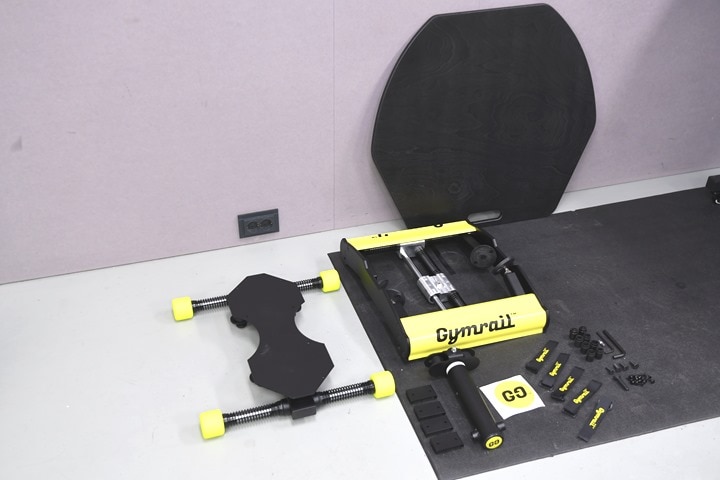
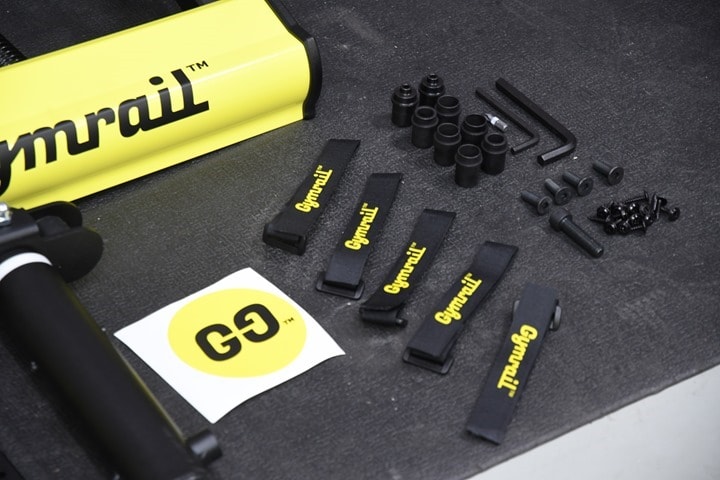
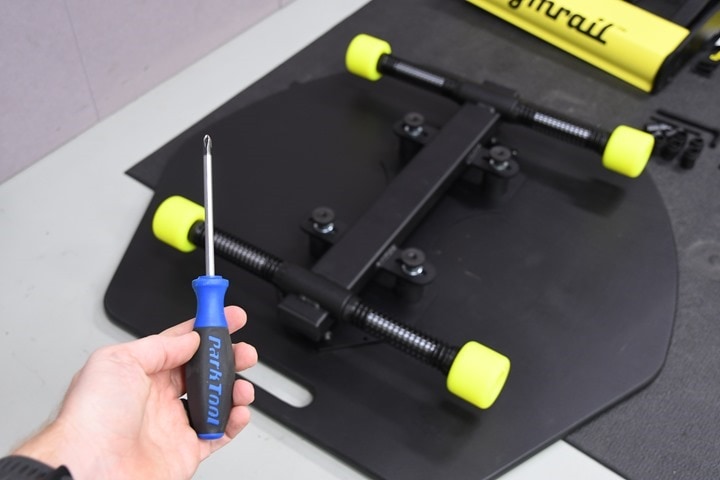
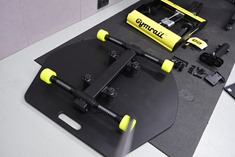
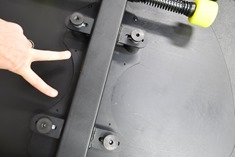
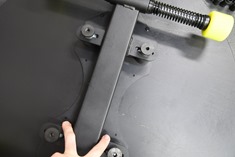
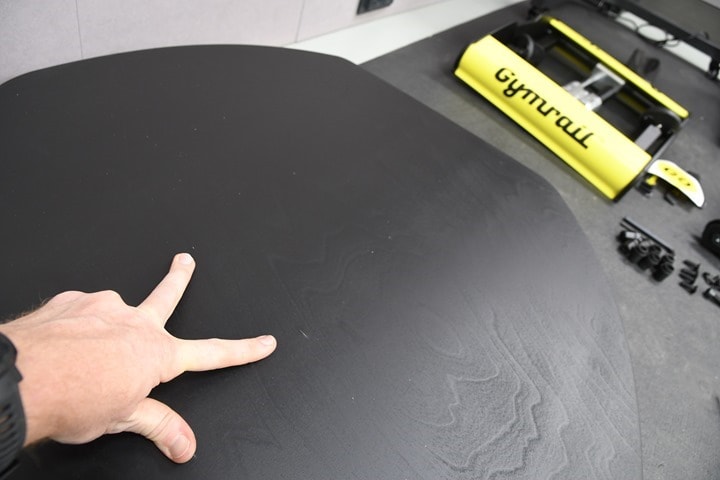
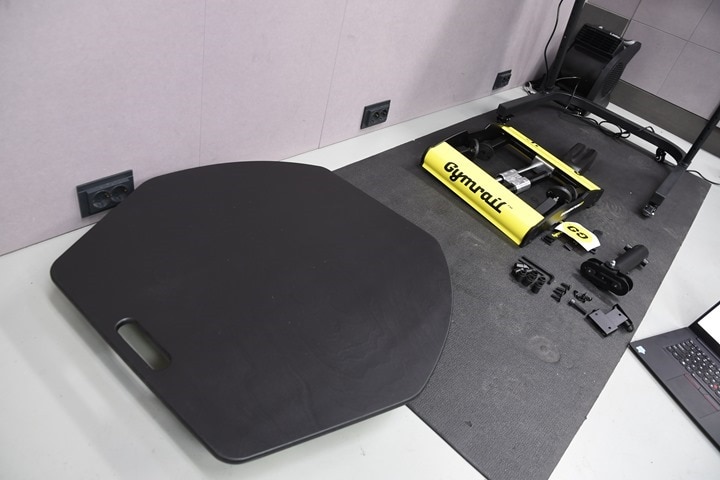
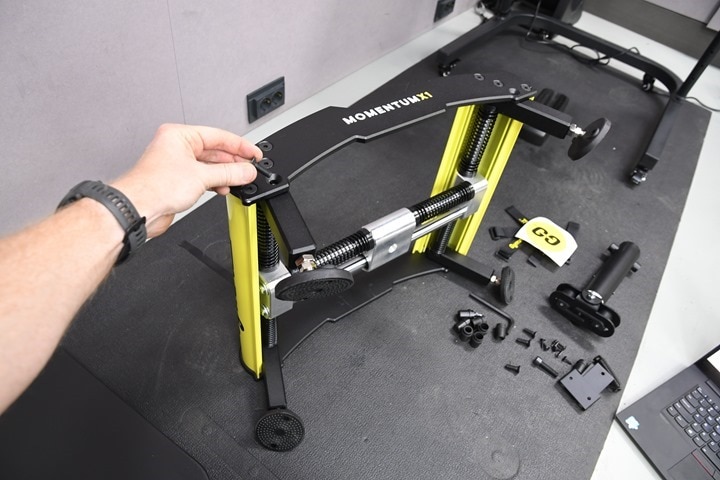
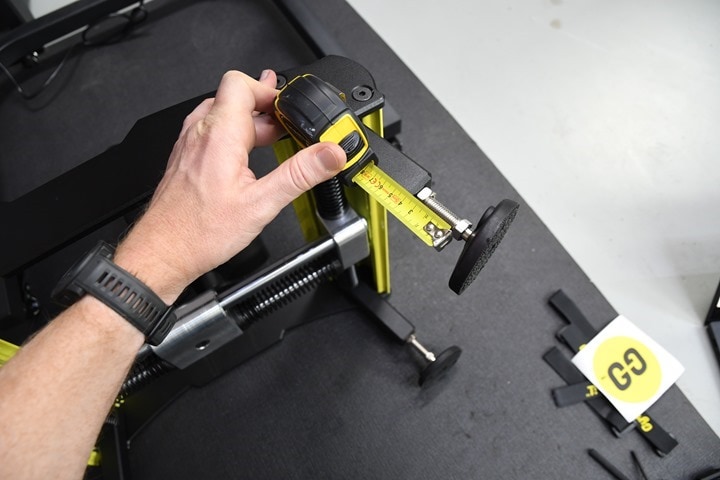
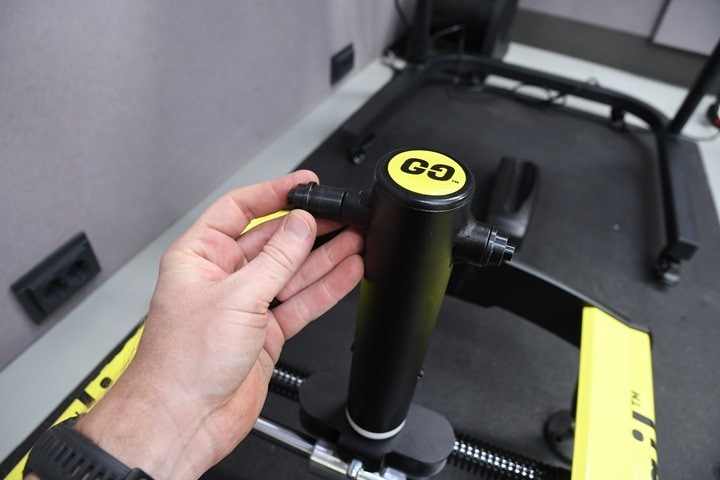
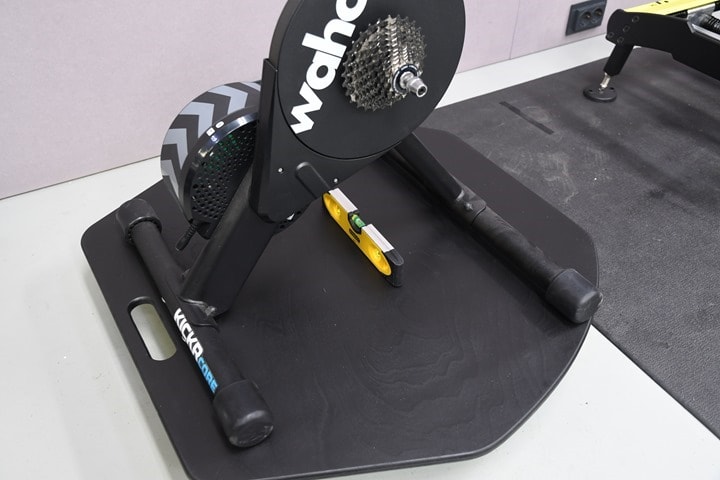
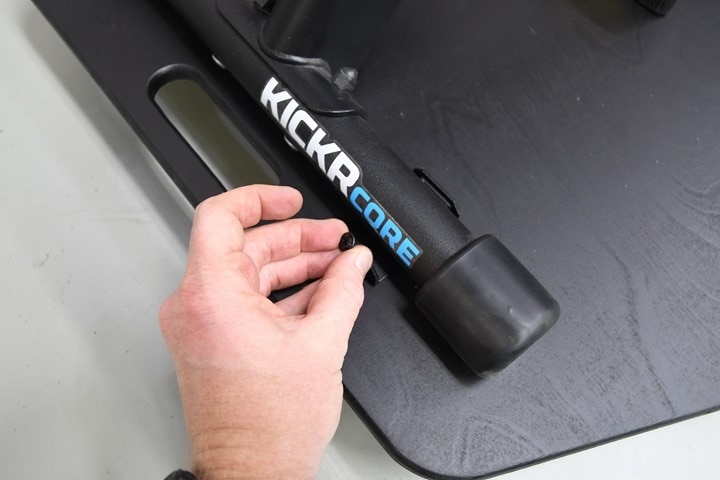
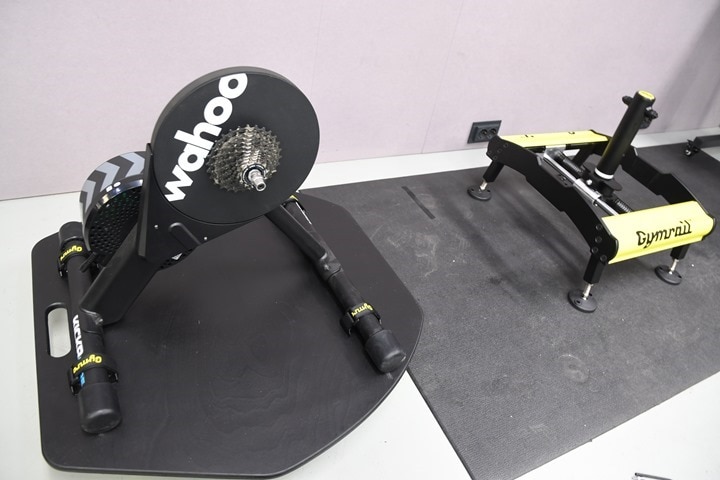
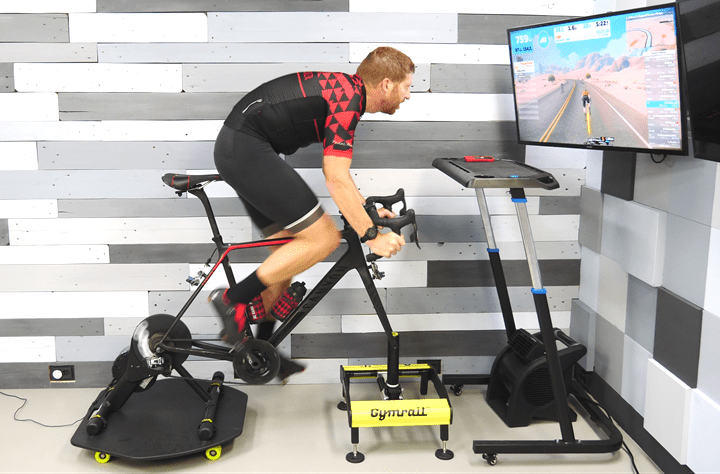
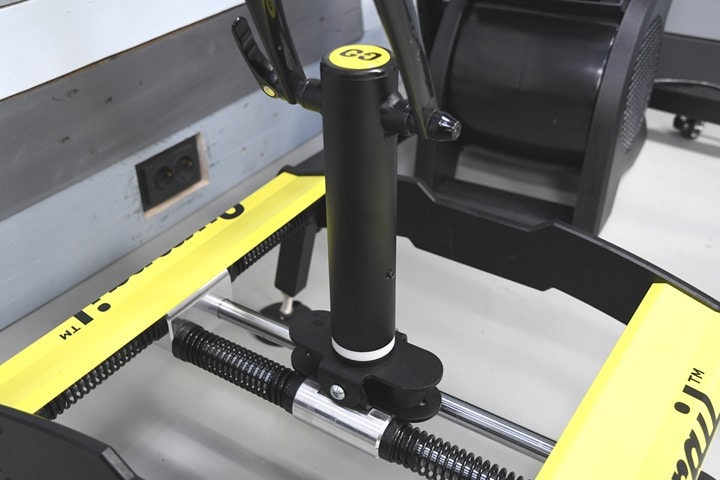
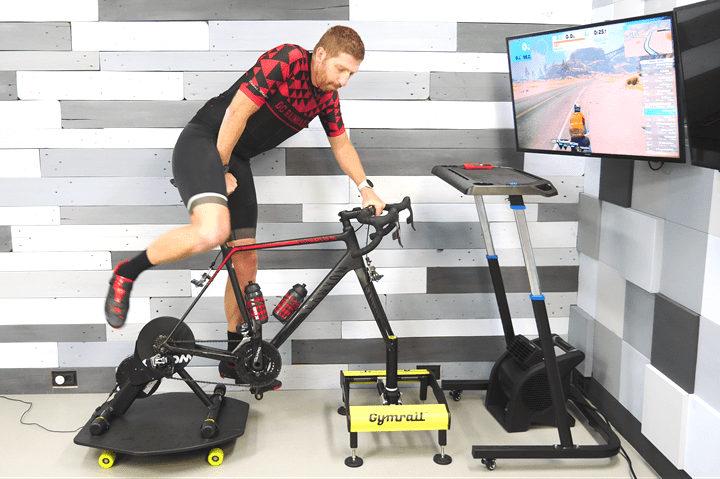
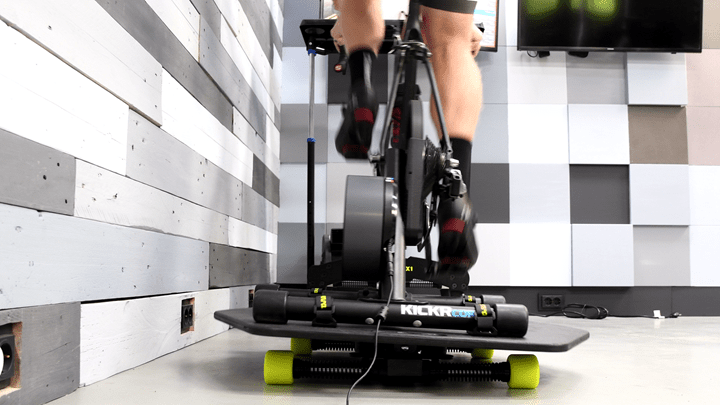
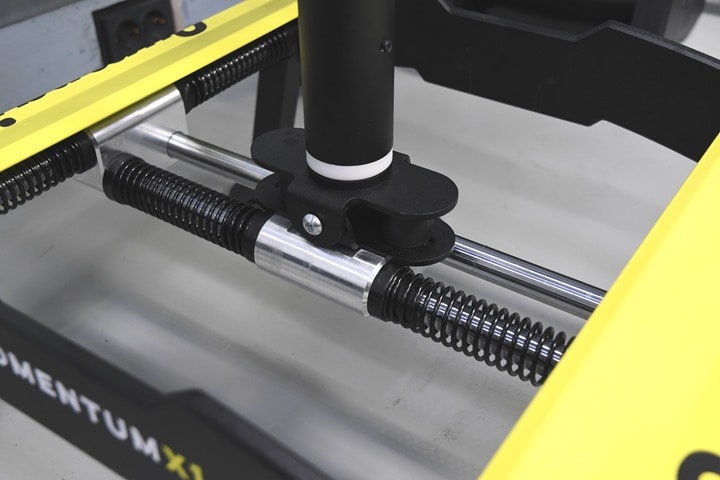

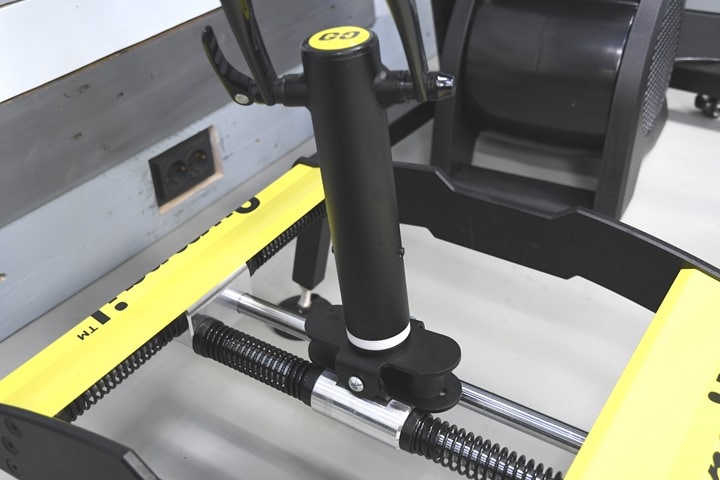
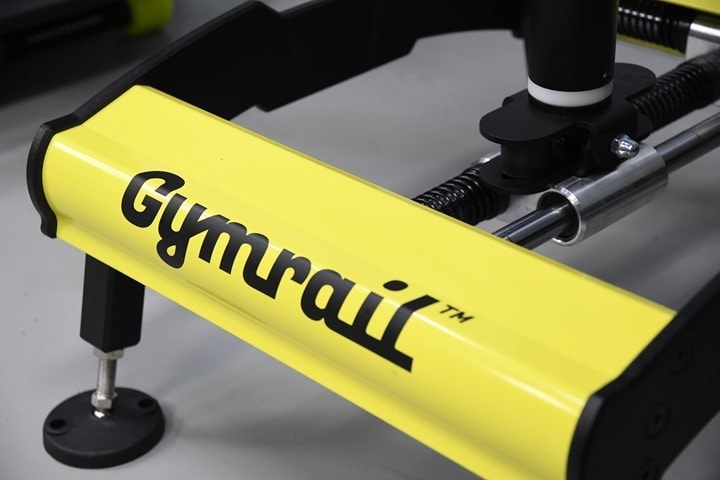
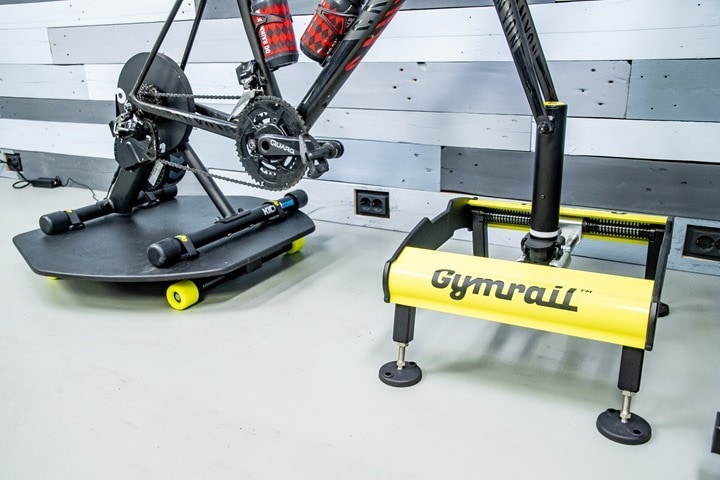

















Do you think we’ll ever see anything like this for the Tacx NEO Bike? They’re even worse for numb-bum as at least with bike-on trainers you get a bit of flex in the bike frame, whereas this is rock solid and you certainly notice it.
I’m not ready to pay £1000 any time soon, but it would be interesting to see if there was a big enough market to make this worth anyone’s effort.
EDIT: I was forgetting that there’s a rocker plate for the KICKR Bike, so maybe.
Yes, there are several makers that offer rocker plates for smart bikes like the Neo. They work as well as those for bike & trainer combos. There are models available around the world from at least a few builders if you are really looking to get one.
Yeah, as Chad said, there are options out there. Ranging from reasonably solid to ‘umm…that seems well beyond sketch’.
To me, that’s sorta the challenge with buying a smart bike right now, the product just isn’t super mature. I think all the pieces are there in theory from different vendors, but nobody really has it nailed yet.
For ride feel, I think the KICKR BIKE is the closest, but of course, it lacks the front screen area (which I know some don’t like, but having ridden Peloton and Technogym bikes now, it’s just such a better way of ensuring a well integrated package).
Then you flip over to the TechnoGym bike, which has the good screen, reasonably good ride feel (but not the sway/elevation of KICKR Bike). And, while not publically announced in any fashion I know of, the most recent models from the last few weeks off the assembly line now even have a very small amount of tilt left and right, using a mini rocker feet built-in, akin to the KICKR AXIS feet, but with a center rotation point. On my to-do list to write-up/share video of.
But even that bike has challenges on the software front. It has Rouvy built-in, and that works rather well. But the Zwift integration isn’t real (it’s just HDMI pass-through), and there’s some other quirks. It’s good, but like everything else, all the options feel like V1 version (cause they are).
And of course, I could basically continue this all the way around one bike after another…
Is this the new TechnoGym bike you’re referencing? The marketing spin looks impressive, and the design seems nicer than the KICKR or Tack bikes, but £3,990? £3,990? Wow. That’s a gutsy price point for an untested luxury / non-essential product launch at the start of a potential recession with high inflation hitting people’s discretionary budgets, after a 2 year cycle when most anyone who needed a smart trainer bought one, and just as Peloton employees were let go. I love the fact that another player has entered the game, but am doubtful that there are enough new buyers at these price points.
link to technogym.com
I have used a tecnogymn “smart bike” at my work gymn. It is BLE capable, and I can used it with ZWIFT. The biggest problem is the touch points, handlebar is not replaceable, saddle does not use the same type of rails of a normal bike, but instead of a city bike. The price is high but it is build for the abuse of a gymn…it will probably last much longer than any of the smart bikes we have at home.
Tom – Correct, that’s the one. I agree, I think the price is too high. That said, I’d argue that they’ve probably got more experience building indoor bikes than anything else except Stages (doing it for decades), so in that sense, it’s a bit different. That said, I still agree pricing doesn’t fit.
Nuno – I think you’re referring to the older gym edition rather than this more home-focused unit. This one has a standard saddle rail system.
Pretty off topic, but any recommendation of a “dumb” piece similarto the front part of this to use my bike on the trainer without a front wheel mounted?
The closest option I have seen for a fork stand is the one from Kreitler. It has enough support for proper stability. The issue is that it takes up even more space than a wheel, so other than the lack of air pressure maintenance, it’s not really worth the money, IMO.
link to kreitler.com
There are a range of DIY options I have seen using those fork mounts meant for transporting bikes in cars and trucks. But you have to build that and make sure it is stable for use.
People are likely better off with a regular wheel and inserting some foam to make a “trainer wheel”. that is what I did to have a no-maintenance option for use with my wheel-off trainers.
Thanks for the information and recommendations! Really appreciate it.
Thanks Ray
How would this work using just the front part with the Kurt Kinetic Rock & Roll in the back?
Are you suggesting the R&R on top of the X1 rear section, or a complete replacement of the X1 rear?
On top would be a disaster.
Replacement would work, but would kill the fore-aft motion aspect in the least. You’d also have a notable height difference between the front & rear axles (R&R low). That could be addressed with spacers under the R&R. But I don’t see a benefit unless you were aiming to reduce degrees of freedom of motion from the X1, or add some level of steering via the front with the R&R.
Considering that the front has all those freedoms, but the R&R on a floor only has the lean, it could lead to some odd loading on the frame as compared to the more “floaty” X1 rear. Not a good combo in any way I can see.
I raise you the R&R suggestion with putting the R1 atop the X1. Which, I believe is one step above when I stupidly tried putting the R1 atop the MP1…
Double Stuff cookies = good
Double Stack motion trainer & motion platform = hospital visit :P
I need more time to share some thoughts that we’ve covered in the FB group when this got introduced, but I really want to thank you for the great coverage and review. Observations and such are all in line with my thoughts and I am happy you are getting these in front of more people to see what’s possible. :D
You mentioned Inside Ride near the beginning of this post. Seems like much ado to offer something that already has all that:
link to insideride.com
I also mentioned it within the Comparative Thoughts section.
But ultimately, I was referring to the Flex system for the KICKR. While the rollers+floating fork are an option, they’re kinda an entirely different beast. Sure, price-wise that’s cheaper, but I wouldn’t say it’s a better trainer experience than this – either in movement, or in actual smart-trainer aspects (because the InsideRide isn’t a super great smart trainer per se, it’s a roller with some smarts). For example, it doesn’t have a lot of gradient resistance, nor does it have a meaningfully usable power meter internally (so you’d need that too).
Point being, the InsideRide solution is great for some, but I don’t really see it competing here for 90% of riders that want to put on any trainer they likely already have (because realistically, anyone looking at this product already has a trainer they’ve undoubtedly bought in the last 2 years).
Any concern with odd torque on your frame? Look like a it could really put some pressure on the head tube/fork area? Must be a great way to void a frame warranty.
I’m thinking the opposite. Out on the smooth road the wheels and bike are free to move in 6 degrees of freedom in responses to forces from accelerations on the CG (incl G) and tire friction and inputs from the rider. I would think rigidly fixing the bike is what creates higher forces…not that I’m concerned about it. I am concerned about how rigidly fixing the bike increases butt hurt forces.
Fascinating gizmo. Eek indeed on price. HOWEVER…if they were to *include* the steering function in the (currently obscene) price, it starts to look a lot more attractive.
Ray, as I write this you and Chad account for 50% of the comments in the discussion of this review. I assume that’s because trainer motion is about as popular as gel saddle covers among your readers.
Many moons ago, you wrote an article outlining what you thought the minimum standard was for a “smart trainer” and it seems the hardware manufacturers met that standard and stalled.
Can you give us a hint at what trends you see in your crystal ball? Or, maybe what trends you’d like to see?
Yeah, I think there’s probably a few factors:
A) Its just too expensive. Thus, people see the price, and pretty much close the tab. If this was priced at half that price, it’d be different.
B) It’s the wrong time of year for this type of stuff. At least in terms of immediate interest. Folks will come back around by fall or so.
C) I think in general, we’ve seen people are temporarily ‘over it’ in terms of being stuck inside for two years of COVID related indoor training. Sure, we’ve gone outside and had breaks from it, and continue to do it. But I detect a strong amount of ‘Just let me ride outside with my friends for the summer’ from a lot of folks. And people are basically turning off their indoor trainer systems.
One can see this if I look at the daily concurrent Zwift numbers, which are astoundingly low right now. People will undoubtedly return this fall as the weather gets crappier, but right now, aside from perhaps a weekday workout, most folks are riding outside.
In terms of this summer/fall, I think it’s actually going to be a reasonably strong year for indoor cycling hardware. I’m just not convinced there’s any consumers left to buy much of it (at least trainers, trainer accessories have a much greater potential). As I’ve said many times recently – anyone who planned to buy a high-end smart trainer has done so over the last 2.5 years.
Nice idea. And the mechanics of this… hurt me.
All I see is forces going directly into the mounting areas, after being deflected somewhat by frame/steerer (bearings/tube).
I’ll refrain from discussing details but on a high level – this is what makes me doubt the solution:
In their natural habitat, all forces will be deflected by counter movements of the body, rotational forces of the wheels, road friction, etc. All/most of this is gone in this setup. It’s got to go somewhere. That will be the frame and the mounting points.
I see this comment a lot, but I just don’t think it’s supported by reality. This rough comment has been repeated in various ways for more than a decade now, and ultimately, it’s just never come true. There’s virtually no cases – ever – of people breaking frames indoors. Like, it’s kinda crazy. Despite millions of people riding all manner of types of frames indoors, there’s nothing people can point to and say ‘This setup broke my frame’ (there’s been one or two cases where people have done stuff like let rust build-up by not wiping down a bike, but that’s no different than outdoors – but again, we’re talking one or two out of millions).
And in terms of stresses, a static trainer is going to drive far more stresses on a frame than something that gives and takes like this.
110% agreed with Ray. Plenty of people see the greater movement of the bike leaning on a motion platform and instantly assume the loading cases on the bike & frame are worse than a typical rigid trainer.
It’s entirely the opposite. A fixed trainer with no movement is the worst case scenario. If there is any lateral lean or movement input from the rider, that leads to notable stress in the frame, especially at the rear triangle, but it propagates throughout. It’s entirely common and natural for a rider on the bike to impart side forces when riding inside, and that increases greatly with more effort. And as noted, despite that great difference from outside riding, bikes breaking on trainers is quite rare.
When you free the bike to move and lean like it does on most motion platforms, that removes that massive stress riser from the trainer connection and gets the frame loading many steps closer to what we experience outside. So, despite what seems like a step in the wrong direction, adding freedom of motion is actually better from a stress/strain perspective on the bike.
With all these Rocker plates – Dont they absorb some of the power from your pedal stroke?
If you are powering the motion of the rocker plate, this has to come from somewhere doesnt it?
The question of power production and/or loss on a motion platform is far from simple. I wrote a primer document with thoughts on the greater intricacies here, so you can check that out below.
But in short, the mere presence of motion from these systems is not a direct line to power loss as many people assume. What matters are the details of how, when and why the motion platform moves. I do believe that some use rockers & use cases do lead to power loss. But there are also many that do not lead to loss at all, while I feel others lead to greater power production.
It’s actually quite complex and anyone making quick and simple claims are likely missing much of the nuance that exists here.
link to docs.google.com
Is the market reaching a density where we can expect a “trainer wobbler” recommendations section in your annual end-of-year trainer recommendations recap? Seems like we’ve seen at least four or five of these reviews in the last year?
Maybe?
Part of the challenge is that some of these are all the same plates, under different names. So the JetBlack/KOM Cycling/Wiggle, and I’m sure countless other names are all the exact same plate. So that makes it a bit messier. The other problem is there’s so many really small (basically 1-2 person) companies doing plates that are more Hobbyist+ than full companies with dedicated support/logistics/etc.
Obviously, it’s super cool that those exist, but it’s hard to try and cover all of them – especially when so many are very similar, or, very specific to a given region.
I think more of a general round-up of the major or more unique players is perhaps the answer, and then a quick listing of some of the ones that are relatively similar but perhaps more regional.
I maintain a bit of a list of the various options and have them mainly sorted by region for easier access. It have not done a lot of work on it lately, but it’s still a decent starting point. I also have a list of reviews from the more active resources just below that.
link to docs.google.com
Cool review, thanks Ray. To me, this feels like a Gen 2 purchase – if they stay alive through Gen 1. A lot of the points you raise (having to decide screw mounting points for yourself, cost, your use of a level to check it is safe to use) make it feel like proof of concept.
Do you know anything about backing? It feels like a cool company that just needs to get through the first model and refine the concept before being a really worthwhile investment.
Do you know anything about backing? It feels like a cool company that just needs to get through the first model and refine the concept before being a really worthwhile investment
Thanks Chris!
We are working hard every single day and we are absolutely sure, that Gymrail could bring more and more innovations, reality and “everseen” features to indoor cycling scene.
This, our first product MX1, is just a start of our journey of development and we have also some very good “backers” ;)
I liked a lot all of your comments and thanks to Ray for your great review of MX1.
Good autumn rides for all and be safe on roads!